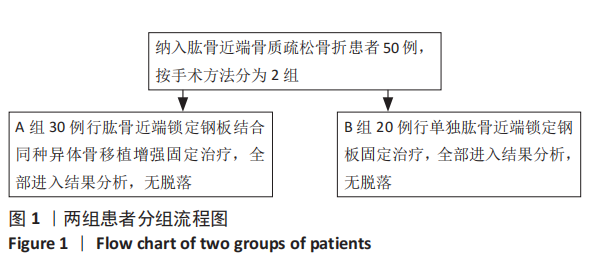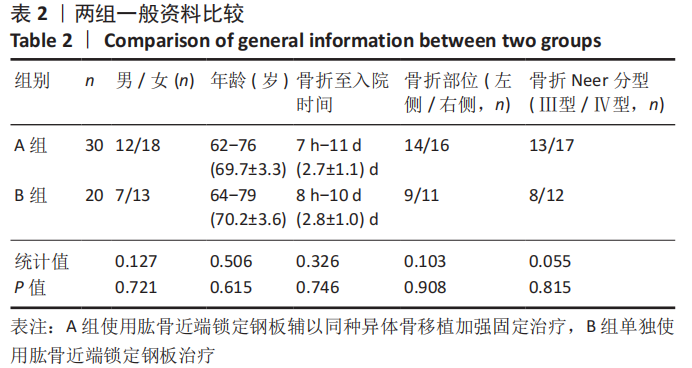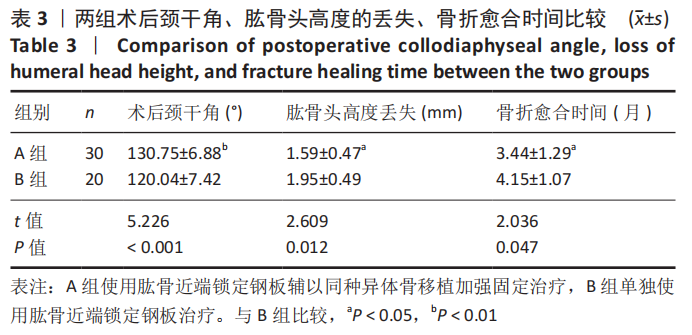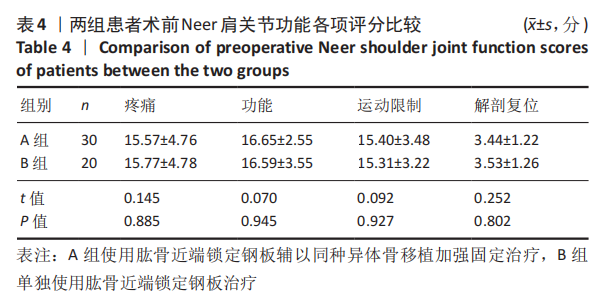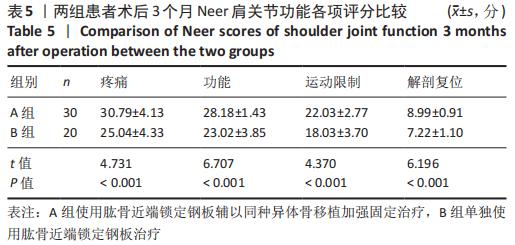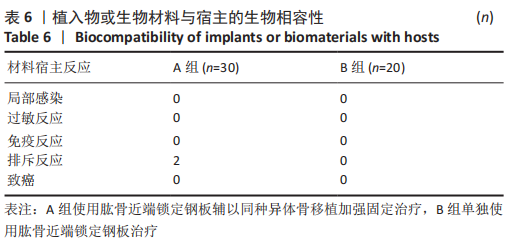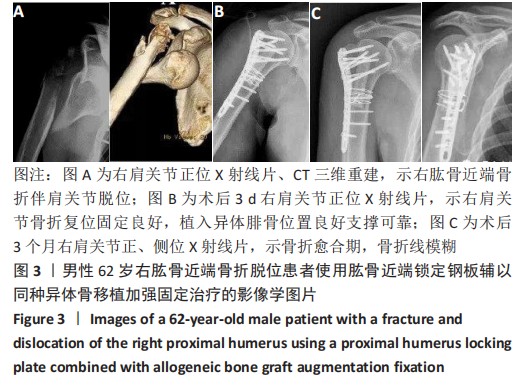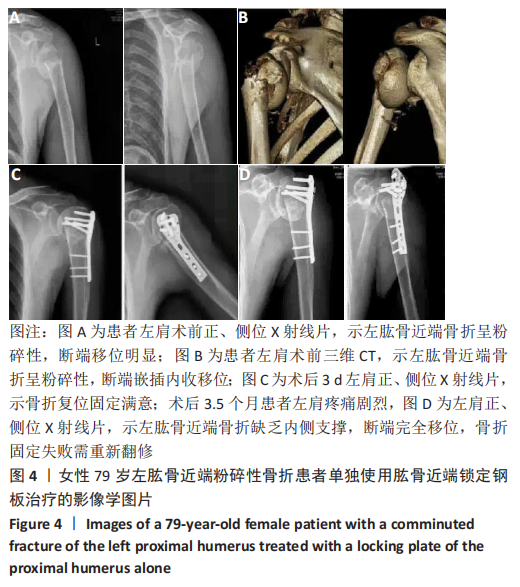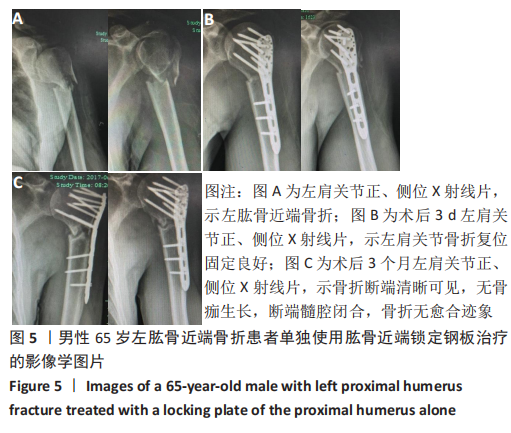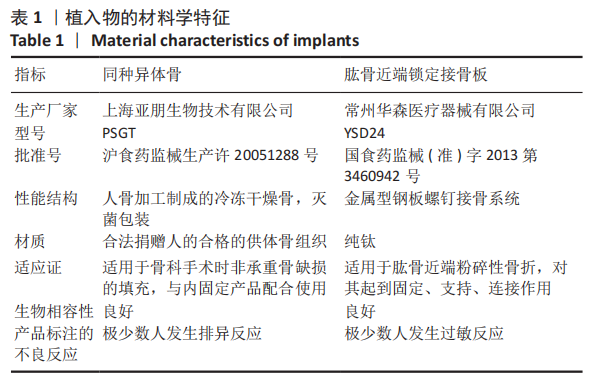中国组织工程研究 ›› 2021, Vol. 25 ›› Issue (27): 4368-4373.doi: 10.12307/2021.198
• 骨科植入物 orthopedic implant • 上一篇 下一篇
肱骨近端锁定钢板结合同种异体骨移植增强固定治疗肱骨近端骨质疏松骨折
潘东续,杨 靖,李耀华,刘玉章,段永刚,钟蔼云,唐晓龙,丁英奇
- 河北北方学院附属第二医院骨科,河北省张家口市 075100
Proximal humerus locking plate combined with allogeneic bone graft in the treatment of proximal humerus osteoporotic fractures
Pan Dongxu, Yang Jing, Li Yaohua, Liu Yuzhang, Duan Yonggang, Zhong Aiyun, Tang Xiaolong, Ding Yingqi
- Department of Orthopedics, the Second Affiliated Hospital of Hebei North University, Zhangjiakou 075100, Hebei Province, China
摘要:
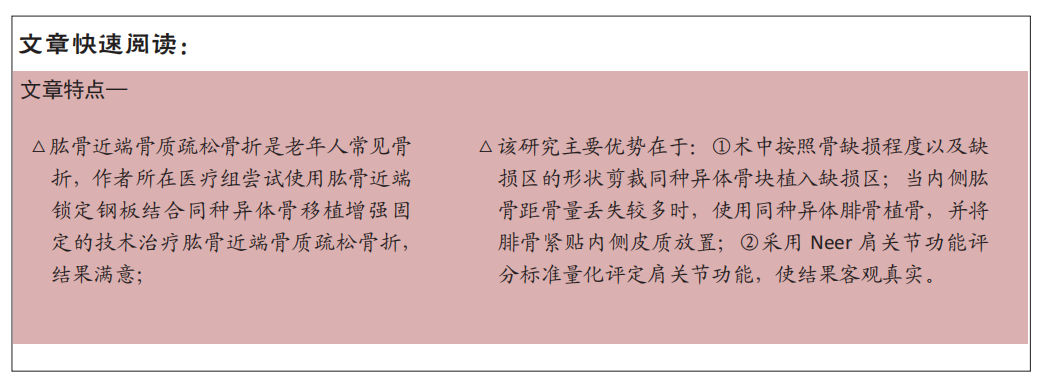
文题释义:
肱骨近端骨质疏松骨折:一般发生于有骨质疏松基础疾病的老年患者,该骨折常发生于肱骨外科颈以远1.0-2.0 cm至肱骨头关节面之间,包括肱骨头、大结节、小结节、肱骨干近端等的骨折。
同种异体骨:是一种取材于自骨捐赠者相应部位而获得的新鲜骨组织,经过灭菌处理以及深低温冷冻技术,使其最大程度地降低感染率,避免了组织抗原性,这样就能安全运用于其他患者骨缺损处的移植填充。
背景:老年肱骨近端骨质疏松骨折发病率逐年增加,由于骨质疏松导致抗力性明显降低,使骨折修复产生困难。
目的:肱骨近端锁定钢板结合同种异体骨移植为一种有效的增强固定方法,分析两种方法结合对肱骨近端骨质疏松骨折的修复效果。
方法:纳入河北北方学院附属第二医院2013年12月至2018年11月收治的肱骨近端骨质疏松骨折老年患者50例,按照不同的手术方法分为A组(n=30)和B组(n=20),A组使用肱骨近端锁定钢板辅以同种异体骨移植加强固定治疗,B组单独使用肱骨近端锁定钢板治疗。比较两组术后颈干角的变化、肱骨头高度丢失、骨折愈合时间以及手术前、后肩关节功能,记录并发症发生情况。
结果与结论:①相对于B组,A组术后肱骨颈干角与正常较为接近(t=5.226,P < 0.001),肱骨头高度丢失显著减少(t=2.609,P=0.012),肱骨近端骨折的愈合时间显著缩短(t=2.036,P=0.047);②术后3个月两组患者疼痛、功能、运动限制及解剖复位评分相对于术前均显著提高(t = 4.731,6.707,4.370,6.196,P < 0.01),并且A组显著优于B组;A组优良率为90%(27/30),显著高于B组的60%(12/20)(χ2=6.294,P=0.012);③术后随访3个月,A组中未出现因为同种异体骨移植发生感染的病例,2例患者出现一过性发热,2例肩关节僵硬,并发症发生率为7%;B组中出现1例内固定失败,1例螺钉穿出,1例钢板断裂,3例肩关节僵硬,并发症发生率为30%;A组并发症发生率显著低于B组(χ2=4.861,P=0.027);④提示同种异体骨移植结合肱骨近端锁定钢板的加强固定方法可明显促进肱骨近端骨质疏松骨折的愈合,改善肩关节的运动功能,并发症少,临床效果明显优于单独使用肱骨近端锁定钢板治疗。
https://orcid.org/0000-0002-4129-3925 (潘东续)
中国组织工程研究杂志出版内容重点:人工关节;骨植入物;脊柱;骨折;内固定;数字化骨科;组织工程
中图分类号:
